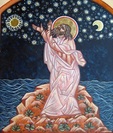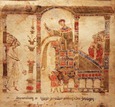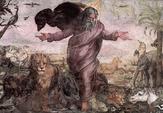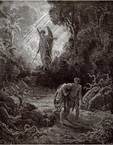Celebrating Sacred Time
Now we move on to a specifically Christian understanding of time. Here we have a modern icon depicting God the Father on the fourth day or creation bringing the great lights in the heavens into being as in Genesis 1. Christians inherited their understanding of time from Judaism; it is a sacred element of life which is unfolding in a straight line between two given points; it began at creation - the Alpha - and will end with the Parousia - the Omega. Thus we live within linear time but we experience time primarily as cyclical. Within the great yearly cycle, there are the lesser weekly and daily cycles. The expectation of the coming of Christ in judgement and an existence beyond this present world is the biggest difference between Christianity's linear concept of time and the recursive or cyclical model found in Eastern religions.
So when that great symbol of Christ, the Paschal candle is blessed at the Easter Vigil service, the following proclamation is made: 'Christ yesterday and today, the Beginning and the End, Alpha and Omega, all time belongs to him and all the ages; to him be glory and power through every age for ever'. This illustration is from a medieval manuscript and shows the deacon singing the 'Exyltet' - the majestic proclamation of Easter which rejoices in the triumph of the risen Christ and celebrates all creation.
The early Christians saw the universe around them as a series of signposts directing them to the Creator; all creation is sacred because it reveals the mystery of the Christ. Time has a sacramental quality and the visible things of nature are signs of a reality that is invisible. Clement of Rome, writing about AD 90, gave a sacramental interpretation to the alternation of time from day to night and made it a symbol of the resurrection: 'We should consider, loved ones, how the Master continuously shows us the future resurrection that is about to occur, of which he made the Lord Jesus Christ the first fruits by raising him from the dead. We should look, loved ones, at the resurrection that happens time after time. Day and night reveal to us a resurrection; the nught sleeps and the day arises; the day departs and the night arrives.'
Time can have various qualities. This is the classic artistic representation of the Genesis myth of Adam and Eve in the Garden of Eden surrounded by the beauty of God's creation - according to this view, time is intrinsically good and holy, part of a good and holy creation as it came fresh from the hand of God. God looked on it and saw that it was good - and that included the element of time. This holiness needs to be celebrated and that is the function of the Liturgy of the Hours. We rejoice in the goodness of God's love expressed in the beauty of creation.
But here we have the corresponding artistic representation of the cause of our need for redemption, again according to Genesis. And now, as Adam and Eve leave Paradise in disgrace, to take their place in a fallen world because of their sin, time becomes part of that fallen world, and shares in its need for redemption. So now, time is in need of sanctification, and this is another aspect of the Liturgy of the Hours. In the New Testament Christians are called to 'redeem the time' (Eph. 5:16) by their holy way of living the Gospel message, and so bring the light of redemption into the darkness of this fallen world.





